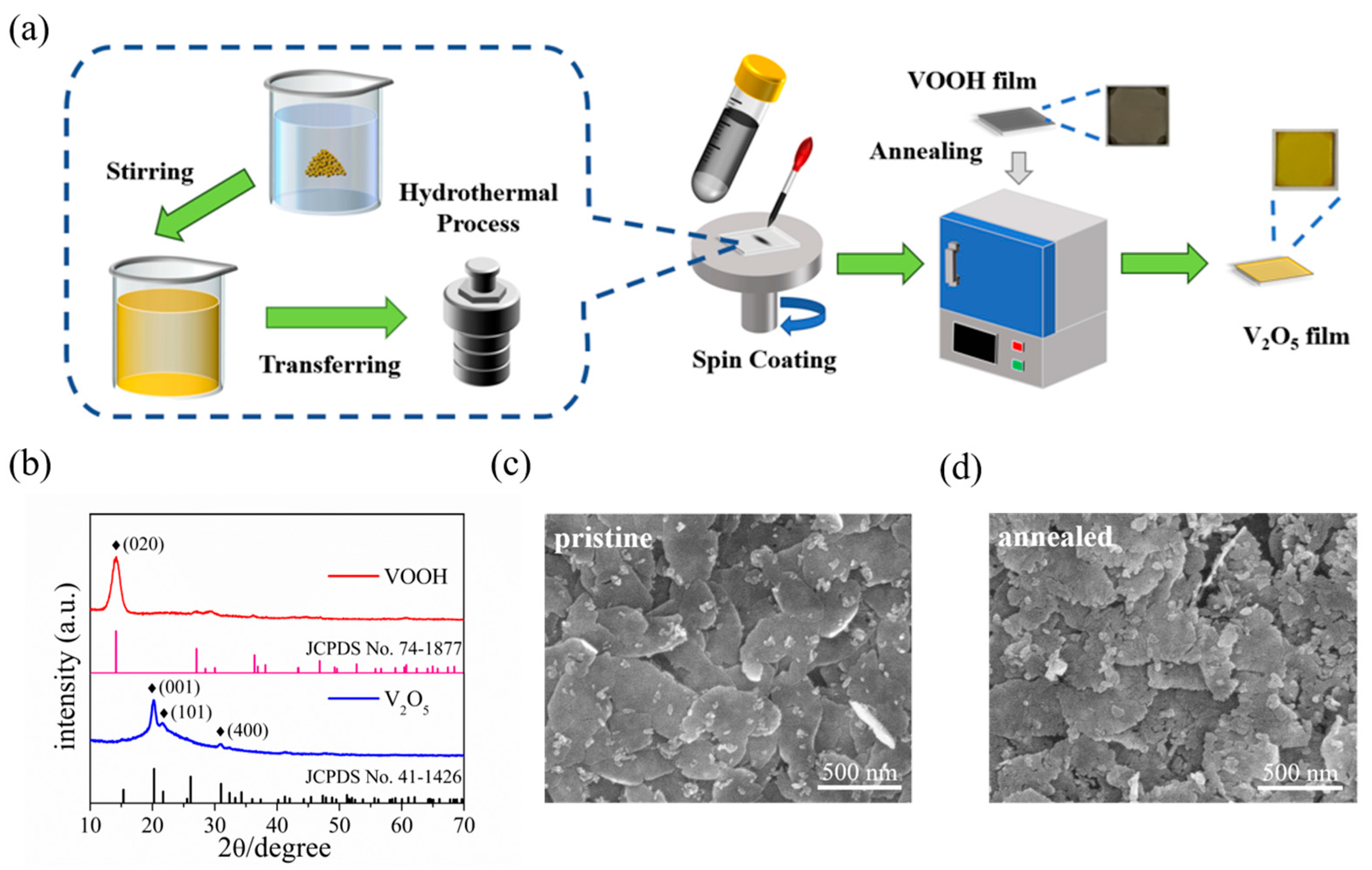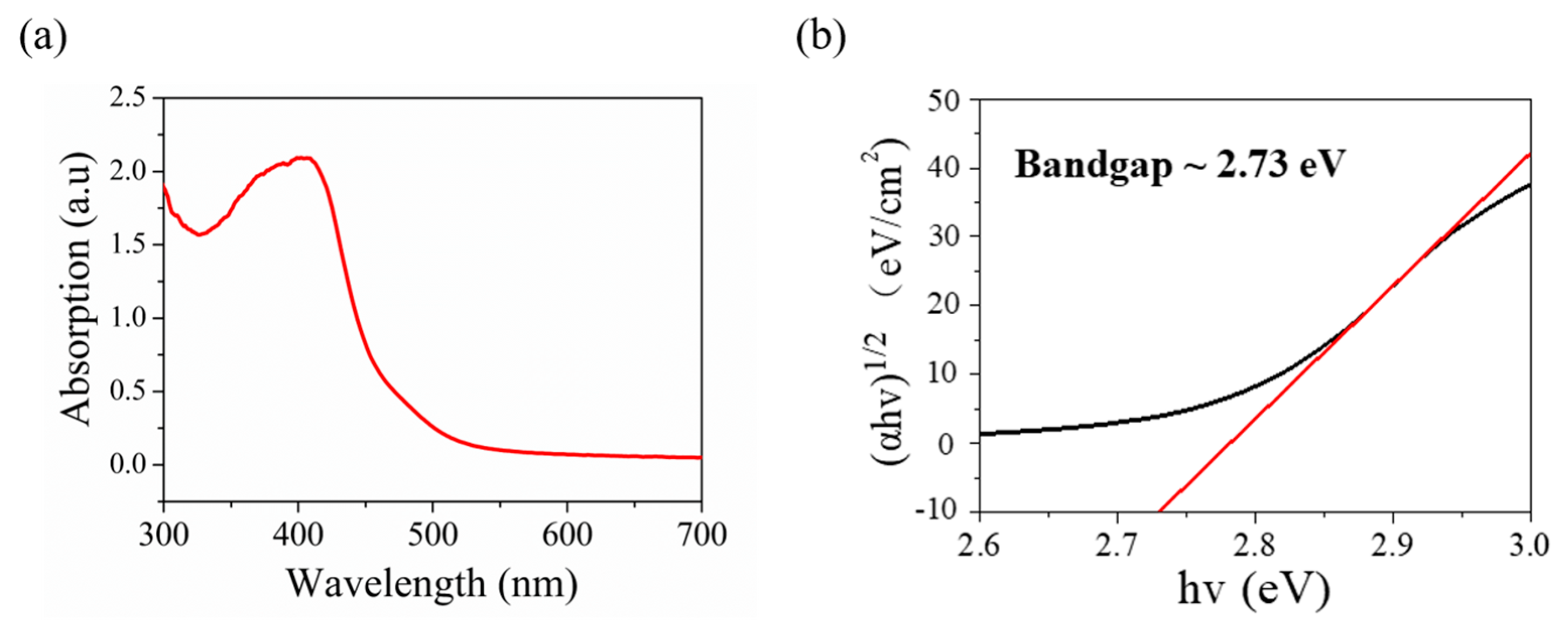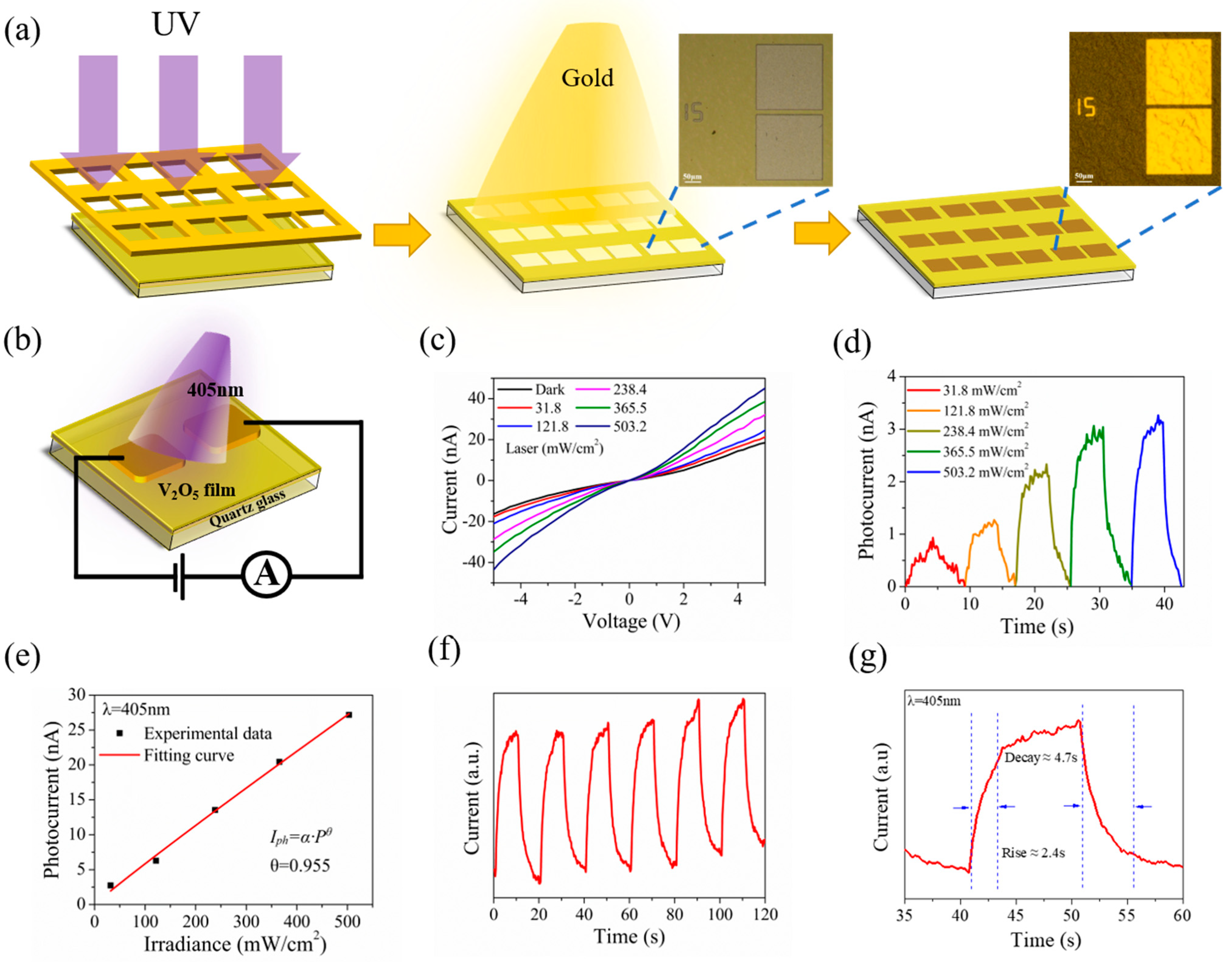Facile Synthesis of Two Dimensional (2D) V2O5 Nanosheets Film towards Photodetectors
Abstract
:1. Introduction
2. Materials and Methods
2.1. Preparation of 2D V2O5 Film
2.2. Device Fabrication and Characterization
3. Results and Discussion
4. Conclusions
Supplementary Materials
Author Contributions
Funding
Institutional Review Board Statement
Conflicts of Interest
References
- Wu, C.; Feng, F.; Xie, Y. Design of vanadium oxide structures with controllable electrical properties for energy applications of the article. Chem. Soc. Rev. 2013, 42, 5157–5183. [Google Scholar] [CrossRef]
- Basu, R.; Dhara, S. Spectroscopic study of native defects in the semiconductor to metal phase transition in V2O5 nanostructure of the article. J. Appl. Phys. 2018, 123, 161550. [Google Scholar] [CrossRef] [Green Version]
- Dewangan, K.; Sinha, N.N.; Chavan, P.G.; Sharma, P.K.; Pandey, A.C.; More, M.A.; Joag, D.S.; Munichandraiah, N.; Gajbhiye, N.S. Synthesis and characterization of self-assembled nanofiber-bundles of V2O5: Their electrochemical and field emission properties of the article. Nanoscale 2012, 4, 645–651. [Google Scholar] [CrossRef] [Green Version]
- Zhai, T.; Liu, H.; Li, H.; Fang, X.; Liao, M.; Zhou, H.; Koide, Y.; Bando, Y.; Golberg, D. Centimeter-long V2O5 nanowires: From synthesis to field-emission, electrochemical, electrical transport, and photoconductive properties of the article. Adv. Mater. 2010, 22, 2547–2552. [Google Scholar] [CrossRef]
- Cao, L.; Zhu, J.; Li, Y.; Xiao, P.; Zhang, Y.; Zhang, S.; Yang, S. Ultrathin single-crystalline vanadium pentoxide nanoribbon constructed 3D networks for superior energy storage of the article. J. Mater. Chem. A 2014, 2, 13136–13142. [Google Scholar] [CrossRef]
- Kim, D.; Yun, J.; Lee, G.; Ha, G. Fabrication of high performance flexible micro-supercapacitor arrays with hybrid electrodes of MWNT/V2O5 nanowires integrated with a SnO2 nanowire UV sensor of the article. Nanoscale 2014, 6, 12034–12041. [Google Scholar] [CrossRef]
- Mai, L.; Dong, F.; Xu, X.; Luo, Y.; An, Q.; Zhao, Y.; Pan, J.; Yang, J. Cucumber-like V2O5/poly (3,4-ethylenedioxythiophene) & MnO2 nanowires with enhanced electrochemical cyclability of the article. Nano Lett. 2013, 13, 740–745. [Google Scholar]
- Kim, G.T.; Muster, J.; Krstic, V.; Park, J.G.; Park, Y.W. Field-effect transistor made of individual V2O5 nanofibers of the article. Appl. Phys. Lett. 2000, 76, 1875–1877. [Google Scholar] [CrossRef]
- Li, Z.; Hu, Z.; Peng, J.; Wu, C.; Yang, Y.; Feng, F.; Gao, P.; Yang, G.; Xie, Y. Ultrahigh Infrared Photoresponse from Core-Shell Single-Domain-VO2/V2O5Heterostructure in Nanobeam of the article. Adv. Funct. Mater. 2014, 24, 1821–1830. [Google Scholar] [CrossRef]
- Abd-Alghafour, N.M.; Ahmed Naser, M.; Hassan, Z. Fabrication and characterization of V2O5 nanorods based metal–semiconductor–metal photodetector of the article. Sens. Actuators A Phys. 2016, 250, 250–257. [Google Scholar] [CrossRef]
- Fu, W.B.; Shang, G.L.; Gong, X.X.; Zhang, L.D.; Fei, G.T. Preparation of large scale and highly ordered vanadium pentoxide (V2O5) nanowire arrays towards high performance photodetectors of the article. J. Mater. Chem. C 2017, 5, 1471–1478. [Google Scholar] [CrossRef]
- Kim, H.-S.; Chauhan, K.R.; Kim, J.; Choi, E.H. Flexible vanadium oxide film for broadband transparent photodetector of the article. Appl. Phys. Lett. 2017, 110, 101907. [Google Scholar] [CrossRef]
- Luo, H.; Wang, B.; Wang, E.; Wang, X.W.; Sun, Y.F.; Li, Q.Q.; Fan, S.S.; Cheng, C.; Liu, K. Phase-transition modulated, high-performance dual-mode photodetectors based on WSe2/VO2 heterojunctions of the article. Appl. Phys. Rev. 2017, 6, 041407. [Google Scholar] [CrossRef]
- Shafique, S.; Yang, S.; Wang, Y.; Woldu, Y.T.; Cheng, B.; Ji, P. High-performance photodetector using urchin-like hollow spheres of vanadium pentoxide network device of the article. Sens. Actuators A: Phys. 2019, 296, 38–44. [Google Scholar] [CrossRef]
- Zeng, W.; Chen, N.; Zhang, L.; Liu, C.; Liu, P.; Xie, F.; Zhou, Y.; Xie, W. Construction of Schottky contact by modification with Pt particles to enhance the performance of ultra-long V2O5 nanobelt photodetectors of the article. J. Colloid Interface Sci. 2021, 607, 1919–1927. [Google Scholar] [CrossRef]
- Grimme, S.; Antony, J.; Ehrlich, S.; Krieg, H. A consistent and accurate ab initio parametrization of density functional dispersion correction (DFT-D) for the 94 elements H-Pu of the article. J. Chem. Phys. 2010, 132, 154104. [Google Scholar] [CrossRef] [Green Version]
- Zhou, B.; He, D. Raman spectrum of vanadium pentoxide from density-functional perturbation theory of the article. J. Raman Spectrosc. 2008, 39, 1475–1481. [Google Scholar] [CrossRef]
- Chen, R.-S.; Wang, W.-C.; Chan, C.-H.; Hsu, H.-P.; Tien, L.-C.; Chen, Y.-J. Photoconductivities in monocrystalline layered V2O5 nanowires grown by physical vapor deposition of the article. Nanoscale Res. Lett. 2013, 8, 443. [Google Scholar] [CrossRef] [Green Version]
- Sahatiya, P.; Sekhar, R.K.C.; Badhulika, S. Discretely distributed 1D V2O5 nanowires over 2D MoS2 nanoflakes for an enhanced broadband flexible photodetector covering the ultraviolet to near infrared region of the article. J. Mater. Chem. C 2017, 5, 12728–12736. [Google Scholar] [CrossRef]
- Pawar, M.S.; Bankar, P.K.; More, M.A.; Late, D.J. Ultra-thin V2O5 nanosheet based humidity sensor, photodetector and its enhanced field emission properties of the article. RSC Adv. 2015, 5, 88796–88804. [Google Scholar] [CrossRef]
- Yalagala, B.P.; Sahatiya, P.; Kolli, C.S.R.; Khandelwal, S.; Mattela, V.; Badhulika, S. V2O5 Nanosheets for Flexible Memristors and Broadband Photodetectors of the article. ACS Appl. Nano Mater. 2019, 2, 937–947. [Google Scholar] [CrossRef]
- Abd-Alghafour, N.M.; Mohammed, S.M.; Ahmed, N.M.; Hassan, Z.; Almessiere, M.A.; Afzal, N.; Bououdina, M. Optimization of Precursor Concentration for the Fabrication of V2O5 Nanorods and their MSM Photodetector on Silicon Substrate of the article. J. Electron. Mater. 2019, 48, 5640–5649. [Google Scholar] [CrossRef]
- Thangarasu, R.; Kulathuraan, K.; Chang, J.H.; Subramani, S.; Chandar, N.R.; Balasundaram, O.N.; Mohanraj, K.; Shkir, M.; Ali, A.M. Influence of zirconium ions on the key characteristics of V2O5 nanorods and current–voltage features of the n-ZrxV2O5/p-Si photodetector of the article. J. Mater. Sci. Mater. Electron. 2022, 33, 2932–2948. [Google Scholar] [CrossRef]
- Abd-Alghafour, N.M.; Ahmed, N.M.; Hassan, Z.; Bououdina, M. High-performance p–n heterojunction photodetectors based on V2O5 nanorods by spray pyrolysis of the article. Appl. Phys. A 2016, 122, 817. [Google Scholar] [CrossRef]
- Lu, J.; Hu, M.; Tian, Y.; Guo, C.; Wang, C.; Guo, S.; Liu, Q. Fast visible light photoelectric switch based on ultralong single crystalline V2O5 nanobelt of the article. Opt. Express 2012, 20, 6974–6979. [Google Scholar] [CrossRef] [Green Version]
- Abdullah, S.M.; Rafique, S.; Azmer, M.I.; Jilani, A.; Sajith, V.K.; Supangat, A. Modified photo-current response of an organic photodiode by using V2O5 in both hole and electron transport layers of the article. Sens. Actuators A Phys. 2018, 272, 334–340. [Google Scholar] [CrossRef]
- Zhang, X.; Lai, Z.; Tan, C.; Zhang, H. Solution-Processed Two-Dimensional MoS2 Nanosheets: Preparation, Hybridization, and Applications of the article. Angew. Chem. Int. Ed. Engl. 2016, 55, 8816–8838. [Google Scholar] [CrossRef]
- Lu, Q.; Yu, Y.; Ma, Q.; Chen, B.; Zhang, H. 2D Transition-Metal-Dichalcogenide-Nanosheet-Based Composites for Photocatalytic and Electrocatalytic Hydrogen Evolution Reactions of the article. Adv. Mater. 2016, 28, 1917–1933. [Google Scholar] [CrossRef]
- Bhakhar, S.A.; Patel, N.F.; Zankat, C.K.; Tannarana, M.; Solanki, G.K.; Patel, K.D.; Pathak, V.M.; Pataniya, P. Sonochemical exfoliation and photodetection properties of MoS2 Nanosheets of the article. Mater. Sci. Semicond. Process. 2019, 98, 13–18. [Google Scholar] [CrossRef]
- Pataniya, P.M.; Sumesh, C.K.; Tannarana, M.; Zankat, C.K.; Solanki, G.K.; Patel, K.D.; Pathak, V.M. Flexible paper based piezo-resistive sensor functionalised by 2D-WSe2 nanosheets of the article. Nanotechnology 2020, 31, 435503. [Google Scholar] [CrossRef]
- Bhakhar, S.A.; Pataniya, P.M.; Tannarana, M.; Solanki, G.K.; Pathak, V.M. Electrophoretic deposition of MoS2 nanosheets for photoelectrochemical type photodetector of the article. Opt. Mater. 2022, 125, 112097. [Google Scholar] [CrossRef]
- Peng, X.; Zhang, X.; Wang, L.; Hu, L.; Cheng, S.H.; Huang, C.; Gao, B.; Ma, F.; Huo, K.; Chu, P.K. Hydrogenated V2O5 Nanosheets for Superior Lithium Storage Properties of the article. Adv. Funct. Mater. 2015, 26, 784–791. [Google Scholar] [CrossRef]
- Song, H.; Zhang, C.; Liu, Y.; Liu, C.; Nan, X.; Cao, G. Facile synthesis of mesoporous V2O5 nanosheets with superior rate capability and excellent cycling stability for lithium ion batteries of the article. J. Power Sources 2015, 294, 1–7. [Google Scholar] [CrossRef]
- Yan, B.; Zhong, S.; Liu, X.; Zhang, L.; Yang, X. Growth of large-area petal-like V2O5 thin nanosheets for superior lithium storage of the article. J. Alloys Compd. 2021, 875, 159899. [Google Scholar] [CrossRef]
- Li, H.T.; Tian, H.; Chang, T.-H.; Zhang, J.; Koh, S.N.; Wang, X.; Wang, C.-H.; Chen, P.-Y. High-Purity V2O5 Nanosheets Synthesized from Gasification Waste: Flexible Energy Storage Devices and Environmental Assessment of the article. ACS Sustain. Chem. Eng. 2019, 7, 12474–12484. [Google Scholar] [CrossRef]
- Huang, J.; Qiao, X.; Xu, Z.; Cao, L.; Ouyang, H.; Li, J.; Wang, R. V2O5 self-assembled nanosheets as high stable cathodes for Lithium-ion batteries of the article. Electrochim. Acta 2016, 191, 158–164. [Google Scholar] [CrossRef]
- Qi, Y.; Qin, K.; Jian, Z.; Yang, X.; Jin, W.; Tan, Y.; Zou, Y.; Chen, W. Ag-functionalized exfoliated V2O5 nanosheets: A flexible and binder-free cathode for lithium-ion batteries of the article. J. Mater. Sci. 2019, 54, 12713–12722. [Google Scholar] [CrossRef]
- Wang, C.; Yi, Y.; Li, H.; Wu, P.; Li, M.; Jiang, W.; Chen, Z.; Li, H.; Zhu, W.; Dai, S. Rapid gas-assisted exfoliation promises V2O5 nanosheets for high performance lithium-sulfur batteries of the article. Nano Energy 2020, 67, 104253. [Google Scholar] [CrossRef]
- Wu, H.; Qin, M.; Li, X.; Cao, Z.; Jia, B.; Zhang, Z.; Zhang, D.; Qu, X.; Volinsky, A.A. One step synthesis of vanadium pentoxide sheets as cathodes for lithium ion batteries of the article. Electrochim. Acta 2016, 206, 301–306. [Google Scholar] [CrossRef]
- Li, Y.; Yao, J.; Evan, U.; Yang, J.; Huang, Y.; Zhang, M.; Cao, G. Leaf-Like V2O5 Nanosheets Fabricated by a Facile Green Approach as High Energy Cathode Material for Lithium-Ion Batteries of the article. Adv. Energy Mater. 2013, 3, 1171–1175. [Google Scholar] [CrossRef]
- Li, M.; Ai, T.; Kou, L.; Song, J.; Bao, W.; Wang, Y.; Wei, X.; Li, W.; Deng, Z.; Zou, X.; et al. Synthesis and electrochemical performance of V2O5 nanosheets for supercapacitor of the article. AIP Adv. 2022, 12, 055203. [Google Scholar] [CrossRef]
- Ko, T.-R.; Lin, C.-Y.; Lai, Y.-H. Facile preparation of functionalized and oxygen-deficient V2O5 nanosheets electrode as a versatile platform for biomimetic- and photoelectro-catalysis of the article. Chem. Eng. J. 2022, 433, 133607. [Google Scholar] [CrossRef]
- Javed, M.S.; Najim, T.; Hussain, I.; Batool, S.; Idrees, M.; Mehmood, A.; Imran, M.; Assiri, M.A.; Ahmad, A.; Shah, S.S.A. 2D V2O5 nanoflakes as a binder-free electrode material for high-performance pseudocapacitor of the article. Ceram. Int. 2021, 47, 25152–25157. [Google Scholar] [CrossRef]
- Liang, S.; Hu, Y.; Nie, Z.; Huang, H.; Chen, T.; Pan, A.; Cao, G. Template-free synthesis of ultra-large V2O5 nanosheets with exceptional small thickness for high-performance lithium-ion batteries of the article. Nano Energy 2015, 13, 58–66. [Google Scholar] [CrossRef]
- Rui, X.; Lu, Z.; Yu, H.; Yang, D.; Hng, H.H.; Lim, T.M.; Yan, Q. Ultrathin V2O5 nanosheet cathodes: Realizing ultrafast reversible lithium storage of the article. Nanoscale 2013, 5, 556–560. [Google Scholar] [CrossRef]
- An, Q.; Wei, Q.; Mai, L.; Fei, J.; Xu, X.; Zhao, Y.; Yan, M.; Zhang, P.; Huang, S. Supercritically exfoliated ultrathin vanadium pentoxide nanosheets with high rate capability for lithium batteries of the article. Phys. Chem. Chem. Phys. 2013, 15, 16828–16833. [Google Scholar] [CrossRef]
- Wang, L.; Shen, G.; Zhao, Y.; Wang, Y.; Zhao, Y. Enhancing lithium/sodium-ion storage behaviors in a V2O5 nanosheet by freeze-drying of the article. Crystengcomm 2022, 24, 5605–5613. [Google Scholar] [CrossRef]
- Ferhati, H.; Djeffal, F. High-Responsivity MSM Solar-Blind UV Photodetector Based on Annealed ITO/Ag/ITO Structure Using RF Sputtering of the article. IEEE Sens. J. 2019, 19, 7942–7949. [Google Scholar] [CrossRef]
- Benyahia, K.; Djeffal, F.; Ferhati, H.; Bendjerad, A.; Saidi, A. Self-powered photodetector with improved and broadband multispectral photoresponsivity based on ZnO-ZnS composite of the article. J. Alloys Compd. 2021, 859, 158242. [Google Scholar] [CrossRef]
- Ferhati, H.; Djeffal, F.; Saidi, A.; Benhaya, A.; Bendjerad, A. Effects of annealing process on the structural and photodetection properties of new thin-film solar-blind UV sensor based on Si-photonics technology of the article. Mater. Sci. Semicond. Process. 2021, 121, 105331. [Google Scholar]
- Zhang, J.; Cui, R.; Gao, C.; Bian, L.; Pu, Y.; Zhu, X.; Liu, X.; Huang, W. Cation-Modulated HER and OER Activities of Hierarchical VOOH Hollow Architectures for High-Efficiency and Stable Overall Water Splitting of the article. Small 2019, 15, e1904688. [Google Scholar] [CrossRef]
- Shi, H.; Liang, H.; Ming, F.; Wang, Z. Efficient Overall Water-Splitting Electrocatalysis Using Lepidocrocite VOOH Hollow Nanospheres of the article. Angew. Chem. Int. Ed. Engl. 2017, 56, 573–577. [Google Scholar] [CrossRef]
- Wei, D.; Tang, W.; Ma, N.; Wang, Y. Ni-doped VOOH as an efficient electrocatalyst for urea oxidation of the article. Mater. Lett. 2021, 291, 129593. [Google Scholar] [CrossRef]
- An, Q.; Zhang, P.; Wei, Q.; He, L.; Xiong, F.; Sheng, J.; Wang, Q.; Mai, L. Top-down fabrication of three-dimensional porous V2O5 hierarchical microplates with tunable porosity for improved lithium battery performance of the article. J. Mater. Chem. A 2014, 2, 3297–3302. [Google Scholar] [CrossRef]
- Silversmit, G.; Depla, D.; Poelman, H.; Marin, G.B.; Gryse, R.D. Determination of the V2p XPS binding energies for different vanadium oxidation states (V5+ to V0+) of the article. J. Electron Spectrosc. Relat. Phenom. 2004, 135, 167–175. [Google Scholar] [CrossRef]
- Kim, T.Y.; Park, S.; Kim, B.J.; Heo, S.B.; Yu, J.H.; Shin, J.S.; Hong, J.-A.; Kim, B.-S.; Kim, Y.D.; Park, Y.; et al. Dual-functional quantum-dots light emitting diodes based on solution processable vanadium oxide hole injection layer of the article. Sci. Rep. 2021, 11, 1700. [Google Scholar] [CrossRef]
- Fu, Y.; Liu, Y.; Ma, K.; Ji, Z.; Mai, W.; Zhao, C. Interfacial engineering to boost photoresponse performance and stability of V2O5/n-Si heterojunction photodetectors of the article. J. Alloys Compd. 2020, 819, 153063. [Google Scholar] [CrossRef]
- Chou, J.Y.; Lensch-Falk, J.L.; Hemesath, E.R.; Lauhon, L.J. Vanadium oxide nanowire phase and orientation analyzed by Raman spectroscopy of the article. J. Appl. Phys. 2009, 105, 034310. [Google Scholar] [CrossRef]
- Guo, X.; Tan, Y.; Hu, Y.; Zafar, Z.; Liu, J.; Zou, J. High quality VO2 thin films synthesized from V2O5 powder for sensitive near-infrared detection of the article. Sci. Rep. 2021, 11, 21749. [Google Scholar] [CrossRef]
- Yan, B.; Liao, L.; You, Y.; Xu, X.; Zheng, Z.; Shen, Z.; Ma, J.; Tong, L.; Yu, T. Single-Crystalline V2O5 Ultralong Nanoribbon Waveguides of the article. Adv. Mater. 2009, 21, 2436–2440. [Google Scholar] [CrossRef]
- Sreedhara, M.B.; Vasu, K.; Rao, C.N.R. Synthesis and Characterization of Few-layer Nanosheets of GaN and Other Metal Nitrides of the article. Z. Für Anorg. Und Allg. Chem. 2014, 640, 2737–2741. [Google Scholar] [CrossRef]
- Yin, S.Q.; Zhao, B.T.; Wan, J.J.; Wang, S.L.; Yang, J.Y.; Wang, X.; Zeng, L.H.; Han, W.; Chen, L.J.; Chen, J.W.; et al. MXene-contact enhanced broadband photodetection in centimeter level GeS films of the article. J. Phys. D Appl. Phys. 2022, 55, 265105. [Google Scholar] [CrossRef]
- Soci, C.; Zhang, A.; Xiang, B.; Dayeh, S.A.; Aplin, D.P.R.; Park, J.; Bao, X.Y.; Lo, Y.H.; Wang, D. ZnO nanowire UV photodetectors with high internal gain of the article. Nano Lett. 2007, 7, 1003–1009. [Google Scholar] [CrossRef]
- Li, Q.; Yang, J.; Quhe, R.; Zhang, Q.; Xu, L.; Pan, Y.; Lei, M.; Lu, J. Ohmic contacts between monolayer WSe2 and two-dimensional titanium carbides of the article. Carbon 2018, 135, 125–133. [Google Scholar] [CrossRef]
- Wu, J.; Ding, S.; Huang, Z.; Li, H.; Huang, K.; Qi, X. Improved photoresponse performances of V2O5 and rGO of the article. Fuller. Nanotub. Carbon Nanostruct. 2019, 27, 566–571. [Google Scholar] [CrossRef]





Publisher’s Note: MDPI stays neutral with regard to jurisdictional claims in published maps and institutional affiliations. |
© 2022 by the authors. Licensee MDPI, Basel, Switzerland. This article is an open access article distributed under the terms and conditions of the Creative Commons Attribution (CC BY) license (https://creativecommons.org/licenses/by/4.0/).
Share and Cite
Wang, S.; Wu, L.; Zhang, H.; Wang, Z.; Qin, Q.; Wang, X.; Lu, Y.; Li, L.; Li, M. Facile Synthesis of Two Dimensional (2D) V2O5 Nanosheets Film towards Photodetectors. Materials 2022, 15, 8313. https://doi.org/10.3390/ma15238313
Wang S, Wu L, Zhang H, Wang Z, Qin Q, Wang X, Lu Y, Li L, Li M. Facile Synthesis of Two Dimensional (2D) V2O5 Nanosheets Film towards Photodetectors. Materials. 2022; 15(23):8313. https://doi.org/10.3390/ma15238313
Chicago/Turabian StyleWang, Shaotian, Liangfei Wu, Hui Zhang, Zihan Wang, Qinggang Qin, Xi Wang, Yuan Lu, Liang Li, and Ming Li. 2022. "Facile Synthesis of Two Dimensional (2D) V2O5 Nanosheets Film towards Photodetectors" Materials 15, no. 23: 8313. https://doi.org/10.3390/ma15238313




